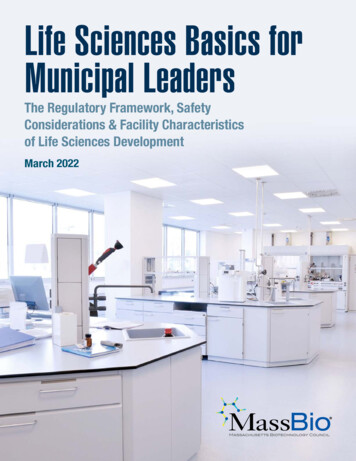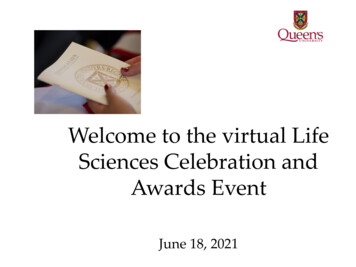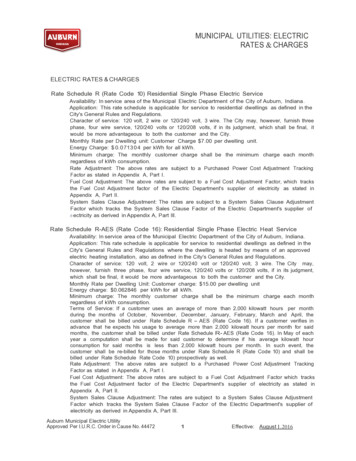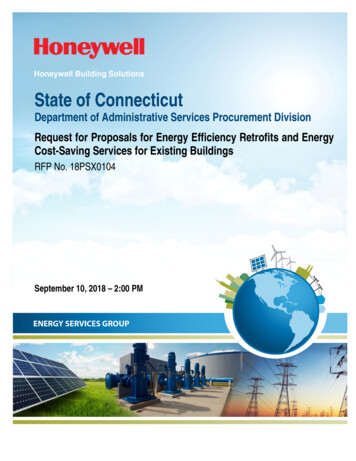
Transcription
Life Sciences Basics forMunicipal LeadersThe Regulatory Framework, SafetyConsiderations & Facility Characteristicsof Life Sciences DevelopmentMarch 2022
Life Sciences Basics forMunicipal LeadersThe Regulatory Framework, Safety Considerations& Facility Characteristics of Life Sciences DevelopmentMarch 2022Welcome from MassBio’s Executive Leadership . Page 3Benefits of Lab and Biomanufacturing Facilities to Host Communities. Page 4Attracting Life Sciences Development to My Community . Page 5BioReady Communities . Page 6General Characteristics of Life Sciences Facilities . Page 8Biotechnology is Highly Regulated and Safe . Page 9What Can a Municipality Do to Proper Regulate Biotechnology Activity? . Page 10Frequency Asked Questions . Page 11About MassBio . Page 12Appendix . Page 13MassBio would like to thank its Board of Directors’ Economic DevelopmentAdvisory Group for their guidance through the development of this resourceas well as the following members of the MassBio community; The Townof Burlington, Berkeley Investments, and Erland Construction.
Welcome from MassBio’sExecutive LeadershipMassachusetts is home to leadingacademic medical centers, universities, earlyand emerging biotech companies, 18 of thetop 20 global biopharma companies andstrong investors. Combined with an immensetalent pool and a unique partnership withgovernment, Massachusetts is the best placein the world for the biotech industry.Over the last fifteen years, Massachusetts has seen 95% growth in employment to over 84,000people working in the biopharmaceutical industry.This coincides with the significant growth in thenumber of biotech companies launching and scaling across the state. This growth has only been possiblealongside a substantial increase in laboratory space in Cambridge, Boston, and many other regional clusters.Over 21.6 million square feet of lab space has been built across Massachusetts over the last 10 years, anincrease of 117% to a total of more than 40 million square feet. During this period, we have seen thesuccessful growth of new clusters in places like Waltham, Lexington, Watertown, and Woburn. Andmany more are on the way up in places like Somerville, Burlington, Beverly, and Norwood.With estimates of an additional 20 million square feet of new lab and biomanufacturing spaceopening in the coming years, MassBio sees significant opportunity for municipalities to developtheir own biotech mini clusters.The goal of this document is to help community officials withinMassachusetts better understand the biotechnology industry, how biotech facilities operate,and what leaders can do to best position their community for successful biotech development.As a trade association representing over 1,500 member companies across the life sciencesin Massachusetts and beyond, MassBio welcomes the opportunity to work with you to helpyour community best position itself for attracting and growing a life sciences cluster.The benefits of these developments are immense for communities and its residents.Please don’t hesitate to reach out to us for further discussion.Sincerely,Joe Boncore, CEO, MassBioKendalle Burlin O’Connell, President & COO, MassBioPage 3
Benefits of Lab and BiomanufacturingFacilities to Host CommunitiesThese modern and active facilities provide anexcellent addition to diversify a municipality’s taxbase, bring new economic opportunity to residents,and invigorate local businesses. As we saw in places likeKendall Square or Watertown, when lab developmenttakes place, restaurants, retail, and housing follow. Whenbiopharma facilities open, foot traffic in the neighborhoodincreases, positively impacting small businesses and restaurants. With the recent economic downturn, the large-scaleshift to remote or hybrid work schedules, new lab and biomanufacturing facilities, where most employees must workin-person, can bring new and welcome economicvitality to a community.While many typically think of life sciences jobs asrequiring a PhD, the reality is that many of the jobsonly require a four-year degree and some entry-leveljobs, especially in biomanufacturing, individuals canbegin fruitful career without a Bachelor’s degree. Ontop of the direct jobs, the biotechnology industry’semployment multiplier is among the highest in theCommonwealth. nPage 4
AttractingLifeSciencesAttracting Life SciencesMyCommunityDevelopmentToDevelopment To MyCommunityThere is no one specific tactic that attracts a lifesciences organization to a municipality. More thananything companies are looking for a municipalpartner, a site that they can occupy in short order,and access to talent.To help community leaders assess what they can do toattract life sciences development in their municipality,MassBio has developed a rating system to determine amunicipality’s readiness to host lab and biomanufacturingfacilities based on the community’s zoning practices andinfrastructure capacity. BioReady rates these communitiesin four tiers from Bronze to Platinum.Through theseBioReady ratings, MassBio seeks to provide cities andtowns a platform to effectively tell their stories to the lifesciences industry that will ultimately help real estatedevelopers and life sciences companies find the mostfavorable destinations to locate.There are currently 90BioReady communities across the Commonwealththat have all made a commitment to hosting thelife sciences industry. nPage 5
BioReadyCommunitiesListed below are the qualifications a municipality must meetBronzeto qualify for each tier—a good guide for any municipalitythinking about attracting any kind of life sciencesdevelopment—from labs to biomanufacturing.Municipalities at this level feature:n Municipal water and sewer available in commercial and industrial areas.n Zoning allows for biotech laboratory and manufacturing uses by special permit.n Identified point of contact in town/city hall to assist biotech projects.SilverMunicipalities at this level feature Bronze Criteria, plus:n Municipality allows biotech laboratory and manufacturing uses by right.n Has identified buildings and/or land sites for biotechnology uses in municipal plans.AND 2 of the following 4:n Municipality convenes site plan review meetings, bringing together all pertinent departments,to provide an overview of the local approvals process for significant commercial and industrial projects.n Has land sites and/or buildings included in MassEconReadyMass100n Community has identified Priority Development Sites per Chapter 43D.n Municipality has a site designated as a Massachusetts Growth District.Page 6
BioReady Communities continuedGoldMunicipalities at this level feature Silver Criteria, plus:n Municipality has sites or buildings pre-permitted for biotechnology laboratoryor manufacturing use.ORn Municipality has existing buildings in which biotech laboratory or manufacturingactivities are taking place.PlatinumMunicipalities at this level feature Gold Criteria plus:n Municipality’s Board of Health has adopted the National Institutes of Health guidelineson rDNA activity as part of its regulations.n Municipality includes a building or buildings that are already permitted for biotech usesand have 20,000 square feet or more of available space for biotech uses.ORn Municipality has a shovel-ready, pre-permitted land site with completedMEPA review and municipal water and sewercapacity to meet additional demand.Massachusetts Bioready Map(as of March 2022)Page 7
General Characteristics ofLife Sciences FacilitiesFrom the building exterior, most life sciencesfacilities look similar to other commercialbuildings.The most visible differences relateto additional ventilation and air purification systemswhich may require additional equipment on the buildingroof. Inside of the building, most facilities have a greaterthan average floor-to-ceiling height to accommodateadditional heating, air conditioning, ventilation, andother utility requirements. For many reasons, thesefacilities are typically not high rises.Facilities differ in size based on the size and stage of thecompany. Labs can range from 1,000 SF (smaller within anincubator) to upwards of 1m SF. In Massachusetts, mostlabs are in the 25,000 to 50,000 SF range. Manufacturingsites locally are typically between 50,000 and 200,000 SFincluding the office and lab space connected to them.Theywill also need loading docks and significantlyhigher ceilings.Biotechnology facilities are generally segregated byfunctional activity between administration, generalbuilding support, laboratory, production, and laboratory/production support.The administration and general building support functions are consistent with other officebuildings including office areas, conference rooms,corridors, elevators and cafeterias.Laboratory units generally combine work benches,biological safety cabinets, chemical fume hoods andfreestanding equipment. In addition, there areassociated laboratory rooms for larger labequipment, special instruments, data processing, glassware washing, solution and media preparation, sampleprocessing/distribution, machine shops, electronic shops,darkrooms, microscopy rooms, and rooms for storage ofsupplies and chemicals.There are also environmentallycontrolled rooms for refrigeration and incubation.Production and manufacturing areas are generally largerversions of laboratories.They are “clean rooms” designedto control the environment in order to protect biologicalprocesses and products from contamination.The airsupply is typically HEPA (high efficiency particulateaerosol) filtered to prevent contamination of the productsfrom airborne microorganisms found in normal outsideair. Employees working in the area are required to wearspecial clothing, such as gowns and gloves, to providea protective barrier between them and the biologicalprocesses and products.Mechanical systems associated with heating, ventilation,and air conditioning (HVAC) are extremely importantand address interior comfort, energy conservation andthe protection of biological processes from normalroom contaminants. Special systems are installed tohighly purify domestic water for use in biologicalprocesses. Animal research facilities, when necessary,have separate HVAC systems to maintain the environmentneeded for the proper care of animals. Facilities generallyhave standby emergency generators to provide powerto critical areas and equipment in the event of apower failure or brownout. nPage 8
Biotechnology isHighly Regulatedand SafeLaboratories involved in biologic research andtesting must conform to rigid regulations. In2020, the U.S. Department of Health and HumanServices, Public Health Service, Centers for Disease Controland Prevention, and National Institutes of Health publishedthe 6th Edition of Biosafety in Microbiological and Biomedical Laboratories (BMBL).The BMBL has become the code of practice for biosafety.Scientists practice biosafety in laboratories to safely andeffectively study biological processes. State-of-the-art labsare designed not only to protect researchers from possiblecontamination, but also to prevent any microorganismsfrom entering the environment.In the 37 year history of biotechnology in Massachusettsthe industry has a strong track record for safety. Regulations, controls, good laboratory practices, and laboriousdocumentation of research all play a role in these highstandards. Additionally, many of the organisms in usecannot survive outside of the controlled environmentsof the laboratories. Laboratory scientists and technicians are hired because of their mastery of good researchpractices.Their success as researchers is based upon theirability to apply these good practices in the research theyconduct and laboriously record in full detail every workingday.The ramifications for a research firm not to follow regulations governing biosafety are severe. Research firms notfollowing sound laboratory practices and the regulationsthat control the industry would lose their standing withgoverning authorities such as the FDA and NIH, as wellas their sources of government, venture, and corporatefunding. Without such funding, no biotechnologycompany could operate.Facilities are categorized on their respective BiosafetyLevels (BSLs) ranging from the lowest risk of BSL-1through the highest of BSL-4. 95% of all labs are BSL-1or BSL-2. In these cases, the safety precautions are toprotect the lab from human exposure as opposed tothe inverse. Some towns have limited the levels ofBSLs that can be located within the municipality. nPage 9
What Can a MunicipalityDo to Properly RegulateBiotechnology Activity?What many communities have done is todevelop a by-law, regulation or ordinancebased on current NIH guidelines. Thesimplest process for such regulation is the adoption ofthe NIH Guidelines as part of the local Board of Health’sregulations.This regulation requires companies to registerwith the Board, giving assurance that its operations willfollow NIH guidelines.These regulations allow the community and the commercial entity to understand what typesof activities will be allowed in the locality.The communitymay choose to adopt the NIH guidelines as a whole aslocal ordinance or adopt specific regulations which mayinclude simply the formation of an Institutional BiosafetyCommittee, which provide a role for the community in theoversight of laboratory activities, with an emphasis onbiosafety. Here are the most current NIH Guidelines.As the biotechnology industry has grown in Massachusettsand as it has been recognized as a highly regulated andsafety-conscious industry, the trend in communityregulations has been to have less-complex regulationsas the biotech industry and the broader scientific fieldhave shown rDNA technology to be very low risk bothto employees and to the broader community. Additionalrequirements, such as special permits, ordinances, orregulatory committees, will create an atmosphere whichdiscourages biotechnology companies from settling in acommunity.The NIH guidelines, together with othersafety and environmental regulations, serve and protectthe community from any potential risks from biotechnology laboratory and manufacturing operations, whilecreating an atmosphere that that welcomes biotechnologyfacility projects. nPage 10
FrequentlyAsked QuestionsQ In what areas are biotech companies doing research?Massachusetts biotechnology companies are focused on cutting edge research for all types of human diseases.Massachusetts is home to some of the most innovative research in the world.Q Are dangerous microorganisms or genetic material released into the water or air?No. Biotech companies operate under strict federal, state, and local guidelines in handling hazardous materials.Any pathogenic, infectious, or otherwise hazardous microorganisms or genetic material is rendered harmlessbefore being released into the environment.QWho monitors biotechnology companies to ensure they are in compliance?Biotechnology companies are subject to a range of federal, state, and local regulations includinglocal community representatives involved in the industry project reviews.QIf the work is safe, why do employees wear special clothing?Protective clothing is provided to protect the products and biological processes from foreign substances,such as human contamination, within the controlled environment. Naturally occurring microorganisms whenintroduced into that environment could interfere, delay or ruin the biological process. Such clothing alsoprotects employees in these settings.QAre animals used in biotechnology research? How are they handled?Animals, primarily rodents such as rats, are a necessary component of scientific research.The FDA requiresanimal research and testing on all drugs and medical devices before they are tested in humans. In handlinganimals, all companies are under the jurisdiction of the U.S. Department of Agriculture and are requiredto conform to the standards of the Animal Welfare Act.QCan people visit biotechnology companies to see what is going on?Most companies welcome visitors at planned and controlled times and have programs with the localeducational community to provide information and promote science education. In addition, InstitutionalBiosafety Committees, formed for those companies involved in recombinant DNA technology, includelocal representatives often chosen by the local Board of Health who visit companies on a regular basis.QWhat can my municipality do to attract biotech companies?More than anything, companies are looking for a municipal partner in the community that they decide to grow up.Anything that a municipality can do to expedite speed to occupancy will be hugely beneficial to the company.Page 11
AboutMassBioMassBio is a not-for-profit organizationfounded in 1985 that represents and provides services andsupport for the #1 life sciences cluster in the world.MassBio’s mission is to advance Massachusetts’ leadership inthe life sciences to grow the industry, add value to the healthcaresystem, and improve patient lives.We represent the premier global life sciences and healthcare hub,with 1,500 members dedicated to preventing, treating, andcuring diseases through transformative science and technologythat brings value and hope to patients. MassBio is also committedto helping communities, local and state governments and regulatoryagencies understand biotechnology, its realized and potentialcontributions to society, the benefits to the local economy,and the specific needs of the industry.MassBio.orgMassBio.org 617.674.5100MassBio HQ 700 Technology Square, 5th Floor Cambridge, MA 02139MassBio WestMassBio North240 Thatcher Road100 Cummings Center, Suite 222-FAmherst, MA 01003Beverly, MA 01915MassBio Central60 Prescott StreetWorcester, MA 01605Page 12
AppendixRegulations Associated withBiotechnology Activities and OperationsBiotechnology facilities are highly regulated and monitored. Below is a list of potential permits,approvals and reports necessary for the approval, construction, and operations of a biotech facility.Certain planning and code requirements, applicable to any property development—such as plumbingor building permits, or site assignments—are not included in the table.The table focuses on activitiesor operations that may trigger environmental, health, and safety related permits, licenses, registrations,or reports. In addition to the below, many municipalities chose to establish an InstitutionalBiosafety Committee (as defined by the National Institutes for Health) through theirBoard of Health or otherwise.Regulatory Authorities GuidePage 13
Potential regulatory permits, submittals, or approvalsapplicable to biotechnology facilities.Multiple requirements may apply.Page 14
Laboratory & Manufacturing Plant Physical RequirementsThe charts which follow identify facility requirements applicable to the five typical biopharmaceutical facilities:1 Basic Research facility2 Process Development facility3 Pilot Production facility4 Manufacturing facilityThe chart titled Facility Space Allocation is designed to show the percentage of space allocated to different functionalareas within the facility.This tool is designed to assist municipalities, citizens and town officials, as well as developersand biotechnology professionals in providing a guideline of engineering and architectural requirements that arecommonly seen in such facilities.This tool is not designed to identify all relevant and applicable requirements.Page 15
Basic Research Facility/Lab Base Building ConsiderationsPage 16
Process Development FacilityPage 17
Pilot Biopharmaceutical Manufacturing FacilityPage 18
Biopharmaceutical Manufacturing FacilityPage 19
MassBio.org 617.674.5100700 Technology Square, 5th FloorCambridge, MA 02139
sciences industry that will ultimately help real estate developers and life sciences companies ind the most favorable destinations to locate. There are currently 90 BioReady communities across the Commonwealth that have all made a commitment to hosting the life sciences industry. n Page 5 Attracting Life Sciences Development To My Community










